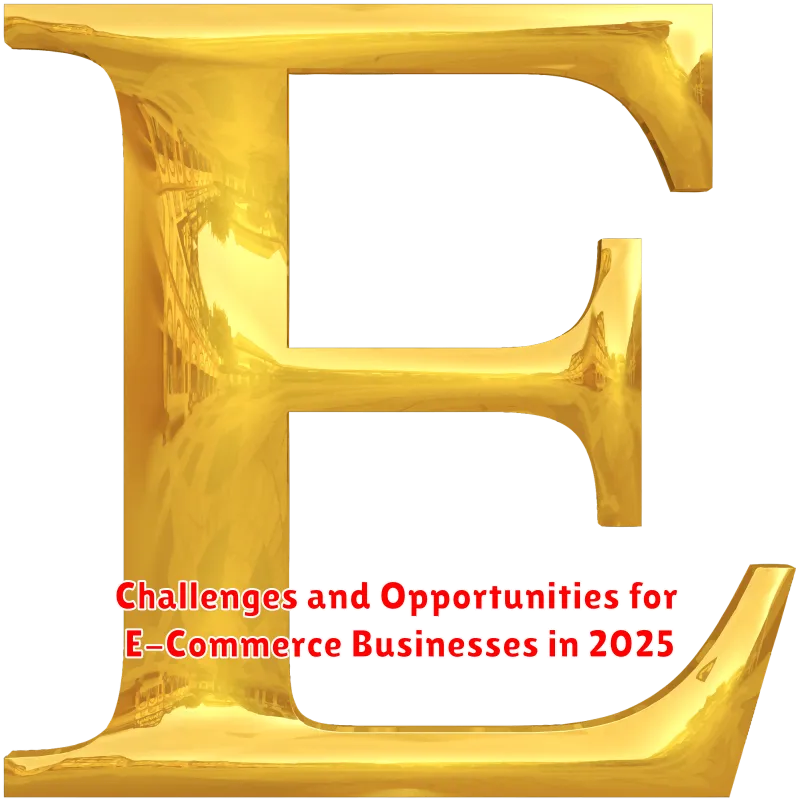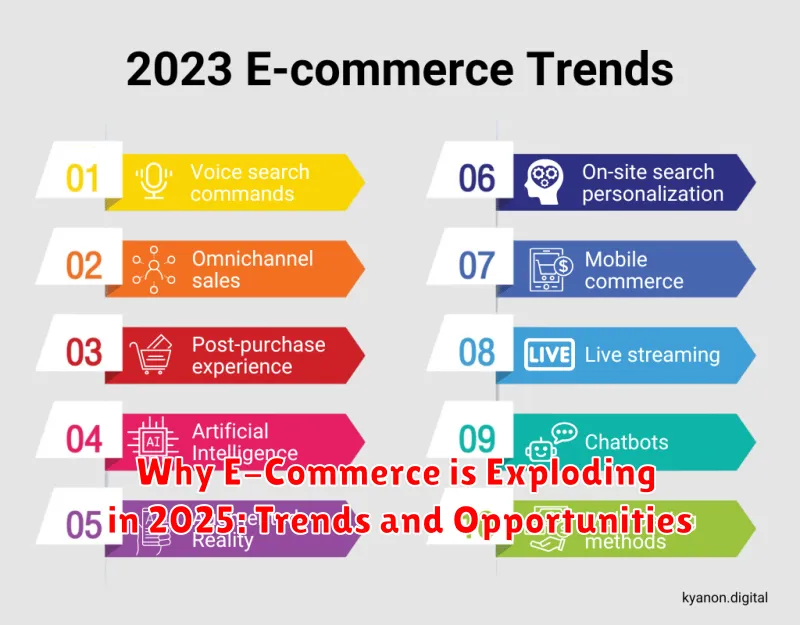The year 2025 marks a pivotal moment for e-commerce, witnessing an unprecedented surge in online shopping and digital transactions. This explosive growth is fueled by a confluence of factors, including evolving consumer behavior, technological advancements, and a rapidly changing global landscape. Understanding the key trends driving this e-commerce explosion is crucial for businesses seeking to capitalize on the vast opportunities presented by this dynamic market. This article delves into the forces shaping the future of e-commerce in 2025 and beyond, exploring the innovative strategies and technologies that are transforming the way we buy and sell online.
From the rise of mobile commerce and the increasing prevalence of social commerce to the integration of artificial intelligence and the growing importance of personalized experiences, the e-commerce trends of 2025 are reshaping the retail landscape. Businesses that embrace these opportunities and adapt to the evolving needs of online consumers are poised for success in this exploding digital marketplace. By exploring the key trends and understanding the underlying forces driving this growth, businesses can develop effective strategies to thrive in the exciting world of e-commerce in 2025.
The Rise of Mobile Commerce and its Impact on E-Commerce
Mobile commerce, or m-commerce, has become a dominant force in the e-commerce landscape. The increasing prevalence of smartphones and improved mobile internet connectivity are key drivers of this growth. Consumers are now more comfortable browsing, comparing, and purchasing products directly from their mobile devices, anytime and anywhere.
This shift to mobile has significantly impacted e-commerce businesses. Companies are now optimizing their websites and online stores for mobile devices to provide a seamless user experience. Mobile apps are also becoming increasingly popular, offering personalized shopping experiences, push notifications for deals, and easy access to customer support.
The rise of m-commerce has also led to the growth of mobile payment systems. Digital wallets and other mobile payment options offer consumers a convenient and secure way to make purchases on their mobile devices. This further streamlines the purchasing process and contributes to the overall growth of e-commerce.
The Growing Influence of Social Media on Online Shopping
Social media has become a powerful force in shaping consumer behavior, profoundly impacting online shopping. Platforms like Instagram, Facebook, and TikTok are no longer just spaces for social connection; they are evolving into dynamic marketplaces.
Social commerce, the practice of selling products directly through social media platforms, is experiencing rapid growth. Features like shoppable posts and integrated checkout options are streamlining the purchasing process, making it easier than ever for consumers to buy products they discover on their social feeds.
Influencer marketing plays a crucial role in this trend. Consumers are increasingly influenced by the recommendations of trusted online personalities, leading to higher conversion rates for brands leveraging influencer partnerships.
The targeted advertising capabilities of social media platforms also contribute to their growing influence on e-commerce. Businesses can precisely target potential customers based on demographics, interests, and online behavior, resulting in more effective advertising campaigns and increased sales.
Personalization and Customer Experience in the E-Commerce Landscape

In the evolving e-commerce landscape of 2025, personalization takes center stage. Customers expect tailored experiences that cater to their individual preferences and needs. This shift necessitates a data-driven approach where businesses leverage customer data to create personalized product recommendations, targeted advertising campaigns, and customized website experiences.
Customer experience (CX) is paramount. A seamless and enjoyable experience across all touchpoints – from browsing to checkout and beyond – is crucial for customer retention and loyalty. This includes optimizing website navigation, providing efficient customer service, and offering flexible delivery options.
Creating a personalized experience also means understanding the customer journey. By analyzing browsing history, purchase patterns, and other data points, businesses can anticipate customer needs and offer relevant solutions. This can translate into personalized email marketing campaigns, exclusive discounts, and tailored product bundles.
The Role of Artificial Intelligence in Shaping the Future of E-Commerce
Artificial intelligence (AI) is poised to revolutionize e-commerce, driving personalized experiences and enhancing operational efficiency. AI algorithms analyze vast datasets of customer behavior, enabling businesses to predict trends and tailor product recommendations with remarkable accuracy.
Chatbots powered by AI provide instant customer support, answering queries and resolving issues in real-time. This not only improves customer satisfaction but also frees up human agents to handle more complex tasks.
AI also plays a crucial role in fraud detection. By identifying suspicious patterns and anomalies, AI algorithms can help businesses prevent fraudulent transactions and protect both customers and businesses from financial losses.
Furthermore, AI-driven inventory management systems optimize stock levels, ensuring that businesses have the right products available at the right time, minimizing storage costs and maximizing sales opportunities. This leads to a more streamlined and cost-effective supply chain.
Emerging Technologies and Their Impact on the E-Commerce Industry
Beyond the established trends, several emerging technologies are poised to revolutionize e-commerce. Augmented Reality (AR) and Virtual Reality (VR) are transforming the way consumers experience products online, offering immersive try-before-you-buy experiences. Imagine virtually placing furniture in your living room or trying on clothes in a virtual fitting room.
Blockchain technology offers increased security and transparency in transactions, building trust and streamlining processes. This can impact everything from supply chain management to payment processing.
The Internet of Things (IoT) connects everyday devices to the internet, creating new opportunities for personalized recommendations and automated purchasing. Smart refrigerators can automatically order groceries, and wearable fitness trackers can suggest relevant health products.
These emerging technologies are not mere novelties; they are reshaping the e-commerce landscape and creating exciting opportunities for businesses that embrace them.
Cross-Border E-Commerce and the Global Marketplace
The global marketplace is rapidly expanding, fueled by the growth of cross-border e-commerce. Reduced trade barriers and improved logistics are making it easier for businesses to reach international customers. This presents significant opportunities for growth, allowing businesses to tap into new markets and diversify their revenue streams.
Consumers are increasingly comfortable purchasing from international retailers, drawn by unique product offerings and competitive pricing. This demand fuels the expansion of cross-border platforms and marketplaces, creating a more interconnected global retail landscape.
Navigating international regulations and understanding cultural nuances are key challenges for businesses engaging in cross-border e-commerce. However, overcoming these hurdles can unlock significant growth potential and establish a strong global presence.
Challenges and Opportunities for E-Commerce Businesses in 2025

E-commerce businesses in 2025 face a dynamic landscape filled with both exciting opportunities and significant hurdles. Competition remains a primary challenge, with businesses needing to differentiate themselves through unique product offerings, exceptional customer service, and personalized experiences.
Supply chain disruptions and fluctuating costs require agile inventory management and diversified sourcing strategies. Cybersecurity threats and data privacy concerns necessitate robust security measures and transparent data handling practices.
However, these challenges also present opportunities. The demand for sustainable and ethical practices creates a market for businesses prioritizing eco-friendly packaging and responsible sourcing. Technological advancements like AI and machine learning offer the potential for personalized marketing, optimized logistics, and enhanced customer service.
Adaptability is key. Businesses that embrace innovation, invest in technology, and prioritize customer needs are best positioned to thrive in the competitive e-commerce landscape of 2025.

